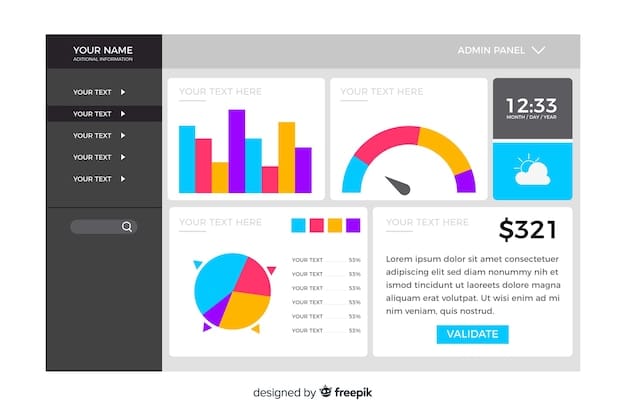E-commerce Marketing Budget: Smart Resource Allocation for Maximum Impact

E-commerce marketing budget allocation involves strategically distributing funds across various channels to maximize ROI, focusing on data-driven decisions and adapting to market trends.
Creating an effective e-commerce marketing budget is crucial for sustainable growth. It’s not just about spending money, but about strategically allocating resources to achieve maximum impact.
Understanding the Basics of an E-commerce Marketing Budget
An e-commerce marketing budget is a financial plan outlining how a business will spend its marketing dollars to attract, engage, and convert customers online. It’s essential for tracking expenses and measuring the effectiveness of different marketing initiatives.
Why is a Marketing Budget Important?
A well-defined marketing budget helps e-commerce businesses make informed decisions, optimize spending, and achieve their sales and growth objectives.
- Strategic Planning: A budget forces you to plan and prioritize your marketing activities, ensuring they align with your overall business goals.
- Resource Allocation: It helps you allocate resources effectively across different marketing channels.
- Performance Measurement: A budget provides a benchmark for measuring the success of your marketing campaigns and identifying areas for improvement.
Without a budget, you risk overspending on ineffective strategies and missing out on opportunities to reach your target audience and grow your online store.
Key Components of an E-commerce Marketing Budget
An effective e-commerce marketing budget considers various components that contribute to the overall marketing strategy. These include advertising, content creation, SEO, email marketing, and social media.
Paid Advertising
Allocate a portion of your budget to paid advertising platforms like Google Ads and social media ads. This can quickly drive traffic and generate leads for your store.
- Google Ads: Target potential customers searching for your products or services.
- Social Media Ads: Reach a specific demographic through targeted advertising on platforms like Facebook and Instagram.
- Retargeting Ads: Re-engage visitors who have previously interacted with your website but haven’t made a purchase.
Paid advertising can be a quick way to drive traffic and sales, but it’s essential to track your campaigns closely and optimize them for maximum ROI.

Strategies for Effective Budget Allocation
Allocating your e-commerce marketing budget effectively involves prioritizing channels based on your target audience, business goals, and available resources. Here are some proven strategies to consider.
Prioritize High-ROI Channels
Focus your budget on the marketing channels that have historically delivered the highest return on investment for your business.
- Analyze Past Performance: Review your previous marketing campaigns to identify which channels generated the most sales and leads.
- Test New Channels: Experiment with new marketing channels, but allocate a smaller portion of your budget to minimize risk.
- Optimize Existing Campaigns: Continuously monitor and optimize your existing campaigns to improve their performance.
By focusing on high-ROI channels, you can maximize the impact of your marketing budget and achieve your sales and growth objectives faster.
Measuring ROI and Adjusting Your Budget
Measuring the return on investment (ROI) of your marketing campaigns is crucial for making informed decisions about budget allocation. It allows you to identify which strategies are working and which ones need improvement.
How to Calculate ROI
ROI is calculated by dividing the net profit generated by a marketing campaign by the cost of the campaign, expressed as a percentage.
By measuring ROI, you can identify underperforming channels and reallocate your budget to those with higher potential.
Tools and Resources for Budgeting and Analysis
Numerous tools and resources are available to help you create, manage, and analyze your e-commerce marketing budget. These tools can streamline your budgeting process and provide valuable insights into your marketing performance.
Budgeting Software and Spreadsheets
Use budgeting software or spreadsheets to track your expenses, forecast future spending, and monitor your progress towards your budget goals.
- HubSpot Marketing Hub: An all-in-one marketing platform with budgeting and analytics tools.
- Google Sheets: A free spreadsheet program that can be used to create and manage your marketing budget.
- Microsoft Excel: A powerful spreadsheet program with advanced features for budgeting and analysis.
Marketing analytics platforms like Google Analytics and Mixpanel can provide valuable data about your website traffic, conversion rates, and customer behavior.

Common Mistakes to Avoid in E-commerce Marketing Budgeting
Many e-commerce businesses make common mistakes when creating and managing their marketing budgets. Avoiding these pitfalls can improve your marketing performance and maximize your ROI.
Inadequate Tracking and Analysis
Failing to track and analyze your marketing performance is a common mistake. Without accurate data, you can’t determine which strategies are working and which ones need improvement.
- Implement Tracking Codes: Ensure you have tracking codes installed on your website and marketing campaigns.
- Regularly Monitor Metrics: Monitor key metrics like website traffic, conversion rates, and ROI on a regular basis.
- Use Analytics Tools: Utilize marketing analytics platforms to gain deeper insights into your marketing performance.
Avoid these common mistakes, track your performance closely, and continuously optimize your budget to achieve your marketing goals.
Future Trends in E-commerce Marketing Budgeting
The field of e-commerce marketing is constantly evolving, and it is important to stay up-to-date on the latest trends. Keeping these trends in mind will help you succeed in the industry.
Increased Focus on Personalization
Personalization will make a big difference in driving sales. Focusing your attention on personalization can change your e-commerce marketing budget.
- AI-Powered Personalization: You can use AI to analyze customer data to deliver personalized product recommendations.
- Dynamic Content: Use dynamic content to ensure users are only shown information that benefits them.
These trends will shape the future of e-commerce marketing budgeting, so it’s essential to stay informed and adapt your strategies accordingly.
| Key Point | Brief Description |
|---|---|
| 💰 Budget Allocation | Distribute funds across channels like PPC and SEO. |
| 📊 ROI Tracking | Measure campaign effectiveness to optimize spend. |
| 🎯 Target Audience | Focus on the segments who are valuable to your business. |
| 📈 Continuous Optimization | Refine strategies based on performance data. |
Frequently Asked Questions
▼
An e-commerce marketing budget outlines planned spending for various marketing activities, like paid advertising and content creation, to attract and convert online customers.
▼
A budget helps you strategically allocate resources, track expenses, and measure the effectiveness of marketing initiatives, leading to better decision-making in the future.
▼
Budget should include SEO, paid addertising, content creation, and email marketing in order to give a wholesome brand experience.
▼
You can calculate your ROI by dividing net profit from your marketing campaign by the overall cost of your marketing campaign.
▼
Some mistakes include not tracking campaign success, not testing new efforts and focusing on the wrong target audience for your product or service.
Conclusion
Creating and managing an effective e-commerce marketing budget is essential for sustainable growth and success. By understanding the key components of a budget, allocating resources strategically, and measuring ROI, you can optimize your marketing spend and achieve your business goals.





